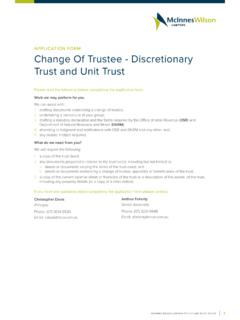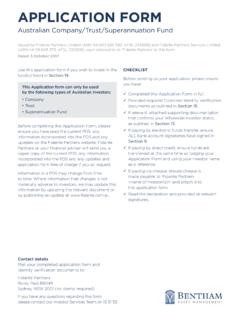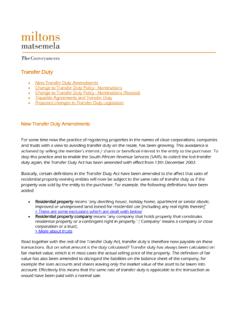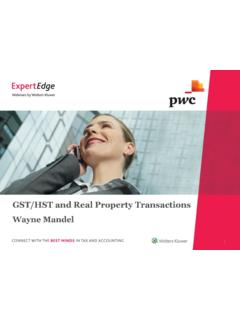Transcription of Trust Overview GMP MSW - Moore Stephens
1 Challenging expectations Trust Overview What is a Trust ? The answer may seem obvious, but in practice many people get confused as to exactly what a Trust is, and what such a structure is meant for. We will examine the various types of Trust recognised under the South African common law, as well as where the Income Tax Act fits in. The Trust Property Control Act 57 of 1998 contains a rather cumbersome definition for a Trust , but the short version is that a Trust is a structure to which property is transferred, and is then administered by trustees on behalf of one or more beneficiaries, in accordance with the Trust instrument (which could be a Trust deed or a will).
2 Section 1 of the Income Tax Act defines a Trust as " any Trust fund consisting of cash or other assets which are administered and controlled by a person acting in a fiduciary capacity, where such person is appointed under a deed of Trust or by agreement or under the will of a deceased person." Alternatively in the context of estate planning, a Trust can be described as a legal relationship which has been created by a person (known as the founder, donor or settlor) through placing assets under the control of another person (known as the trustee ) during the founder s lifetime (an inter vivos Trust ) or on the founder s death (will Trust , testamentary Trust or Trust mortis causa) for the benefit of third persons (the beneficiaries).
3 They can also confer different rights on the beneficiaries concerning the distribution of income and capital. A "vesting Trust " is one where the Trust instrument stipulates when and how income and capital is to be distributed to beneficiaries, where as a "discretionary Trust " allows the trustees to decide when and how such distributions are to be made, if at all. challenging expectations Our law also recognises three types of Trust : An "ownership Trust ". This is where the Trust founder transfers ownership of assets into a structure that is to be administered by a trustee for the benefit of one or more Trust beneficiaries.
4 A "bewind Trust ". In a bewind Trust , the founder makes a gift or bequest to the beneficiary and vests the administration of the assets in the administrator or trustee . With this kind of Trust , the Trust beneficiaries acquire ownership of the assets, with the trustee having only administrative control thereof. The term comes from Dutch law (bewind) and Roman-Dutch law (bewindhebber). A "curatorship Trust ". This Trust is often similar in structure to a bewind Trust , except that the assets are administered on behalf of a beneficiary that lacks capacity to manage their own affairs.
5 As a result, trusts tend to be described in various ways, for example, in relation to their method of formation (inter vivos and testamentary trusts); the rights they confer on beneficiaries (vesting and discretionary trusts); or their purpose (trading trusts, asset protection trusts, special trusts, charitable trusts). However, it's important to note that all of these descriptions are not mutually exclusive. For example, a Trust is founded during a person's lifetime (inter vivos), for purposes of administering a rental property portfolio on behalf of beneficiaries (ownership / trading Trust ), where the trustees exercise discretion in distributing income or capital (discretionary Trust ).
6 Special and charitable trusts There are two particular types of Trust that are defined by the Income Tax Act which, under certain circumstances, can qualify for preferential tax treatment. These are: A "special" Trust . Under Section 1 of the Income Tax Act, this type of Trust can take on one of two forms. Paragraph (a) deals with trusts set up for the benefit of mentally or physically disabled persons, while paragraph (b) deals with trusts set up in terms of a person's will specifically for the benefit of minors.
7 Challenging expectations Special trusts falling under the Paragraph (a) definition have a more favourable tax treatment as far as Capital Gains Tax is concerned A "charitable Trust ". Trusts set up for charitable purposes can qualify for exemption from income tax and CGT under Section 10(1) provided that it carries on an approved public benefit entity listed under Part I of the Ninth Schedule. It also needs to be registered as a Public Benefit Organisation by the SARS Tax Exemption Unit.
8 Donations to such a Trust will also be exempted from donations tax. Offshore trusts Since the partial relaxation of exchange controls a few years back allowing South Africans to invest up to R2m offshore, many such investors have formed trusts in which to house such investments. Many such trusts tend to be formed in so-called tax haven countries - those that impose zero or low rates of tax on trusts - many of which embrace the English common law. According to the SARS Comprehensive Guide to Capital Gains Tax issued on December 12 2007, some of the terminology found in these offshore jurisdictions includes the following: A "bare" Trust (or simple Trust ).
9 This type of Trust is found mainly in the United Kingdom, and has similar characteristics to a bewind Trust . Under a bare Trust , the beneficiaries have immediate and absolute entitlement to the income and capital of the Trust , and have the right to take actual possession of Trust property. A trustee of a bare Trust has no active duties to perform, and is essentially a nominee. A "blind" Trust , also known as a "limping" Trust or "black hole". This is a highly secretive vehicle typically formed for the purpose of concealing assets from revenue or exchange control authorities.
10 It is impossible to identify the settler, the purpose of the Trust or true beneficiaries from the Trust deed. A dummy settler establishes the Trust by donating a nominal sum to a trustee . The Trust deed contains the name of a discretionary beneficiary (for example, the Red Cross), but that beneficiary is usually not informed of its status as a beneficiary. The trustees have the discretion to add or change the beneficiaries. The true beneficiaries are named in a letter of wishes' provided to the trustee .









